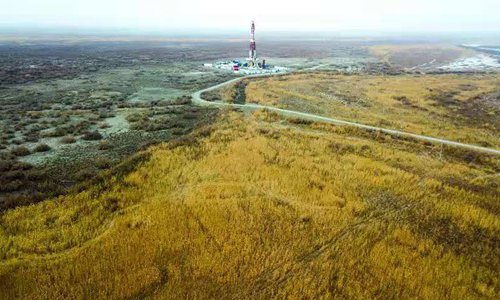HOME >> SOURCE
CNPC’s 8,000-meter-deep well in Xinjiang wells up with oil
By Wang Sheng Source:Global Times Published: 2020/1/20 19:48:40
Daily production is expected to hit 133.46 cubic meters of oil and 48,700 cubic meters of natural gas

A view of the 8,882-meter-deep oil and natural gas well in Northwest China's Xinjiang Uyghur Autonomous Region Photo: Courtesy of CNPC
An 8,000-meter-deep well in Xinjiang Uygur Autonomous Region's Tarim Basin, drilled by China National Petroleum Corp (CNPC), welled up with oil on Sunday.The well's daily output is expected to hit 133.46 cubic meters of oil and 48,700 cubic meters of natural gas, according to CNPC.
The well is the deepest of any onshore oilfield in Asia, and its discovery highlights China's achievements in drilling technology.
"The depth of the newly discovered well is rare. Oil and gas wells in China mainly range from 200 meters to 5,000 meters [in depth]," a petroleum engineer told the Global Times on Monday.
The find is an outcome of enhanced risk exploration. CNPC has made several significant oil and gas discoveries since the company reinforced enhanced risk exploration.
CNPC will maintain its enhanced risk exploration investment at 5 billion yuan ($730.94 million) in 2020. The company boosted its investment five-fold to 5 billion yuan in 2019, up from 1 billion yuan in 2018, in a bid to increase its oil and gas reserves and production.
With mature oil and gas fields deteriorating, Chinese oil giants are facing high costs of exploration, which will be felt even more keenly as international oil prices are unlikely to rise significantly in the coming years. However, China's three state-owned oil companies continue to step up their enhanced risk exploration to stabilize the domestic oil and gas output and ensure the country's energy security. China will fully open its oil and gas market to private and foreign companies from May 1, according to a press release from the Ministry of Natural Resources in January.
Looking ahead, new technologies including big data and artificial intelligence have the potential to maintain domestic oil and gas output.
RELATED ARTICLES:
Posted in: INDUSTRIES